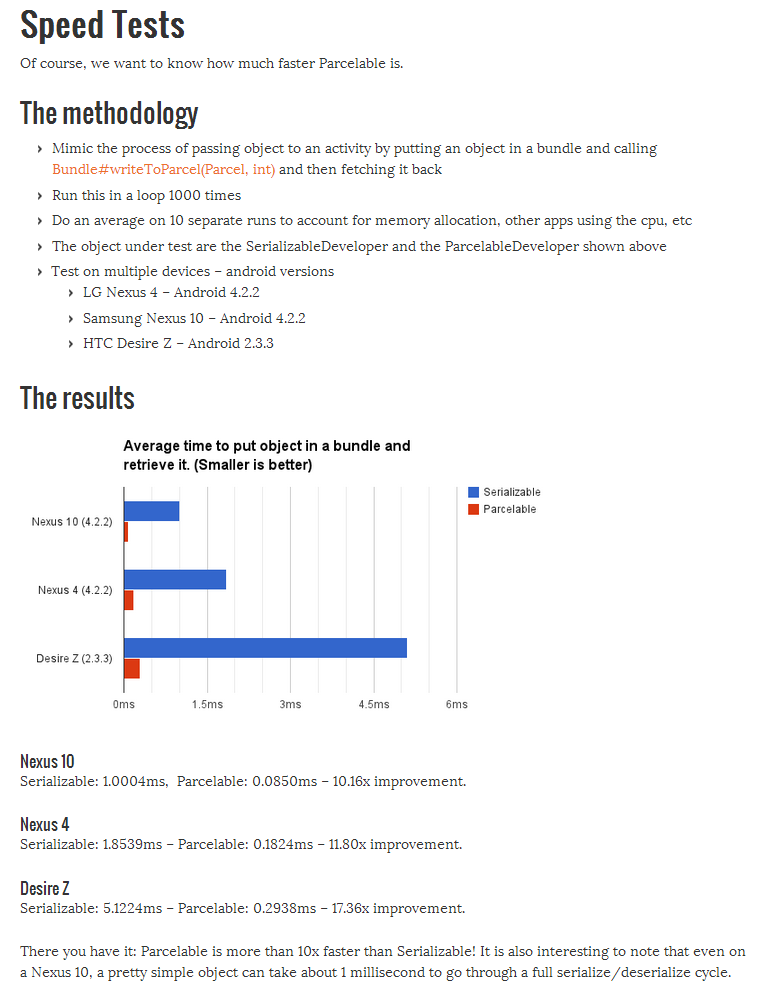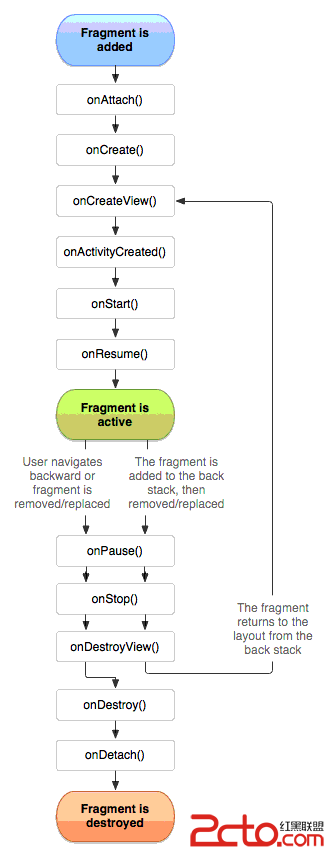編輯:關於Android編程
pendingIntent字面意義:等待的,未決定的Intent。
要得到一個pendingIntent對象,使用方法類的靜態方法getActivity(Context, int, Intent, int),getBroadcast(Context, int, Intent, int),getService(Context, int, Intent, int) 分別對應著Intent的3個行為,跳轉到一個activity組件、打開一個廣播組件和打開一個服務組件。
參數有4個,比較重要的事第三個和第一個,其次是第四個和第二個。可以看到,要得到這個對象,必須傳入一個Intent作為參數,必須有context作為參數。
pendingIntent是一種特殊的Intent。主要的區別在於Intent的執行立刻的,而pendingIntent的執行不是立刻的。pendingIntent執行的操作實質上是參數傳進來的Intent的操作,但是使用pendingIntent的目的在於它所包含的Intent的操作的執行是需要滿足某些條件的。
主要的使用的地方和例子:通知Notificatio的發送,短消息SmsManager的發送和警報器AlarmManager的執行等等。
Android的狀態欄通知(Notification)
如果需要查看消息,可以拖動狀態欄到屏幕下方即可查看消息。
步驟:
1獲取通知管理器NotificationManager,它也是一個系統服務
2建立通知Notification notification = new Notification(icon, null, when);
3為新通知設置參數(比如聲音,震動,燈光閃爍)
4把新通知添加到通知管理器
發送消息的代碼如下:
//獲取通知管理器 NotificationManager mNotificationManager = (NotificationManager) getSystemService(Context.NOTIFICATION_SERVICE) int icon = android.R.drawable.stat_notify_chat; long when = System.currentTimeMillis();//通知發生的時間為系統當前時間 //新建一個通知,指定其圖標和標題 Notification notification = new Notification(icon, null, when);//第一個參數為圖標,第二個參數為短暫提示標題,第三個為通知時間 notification.defaults = Notification.DEFAULT_SOUND;//發出默認聲音 notification.flags |= Notification.FLAG_AUTO_CANCEL;//點擊通知後自動清除通知 Intent openintent = new Intent(this, OtherActivity.class); PendingIntent contentIntent = PendingIntent.getActivity(this, 0, openintent, 0);//當點擊消息時就會向系統發送openintent意圖 notification.setLatestEventInfo(this, “標題”, “我是內容", contentIntent); mNotificationManager.notify(0, notification);//第一個參數為自定義的通知唯一標識
重點是setLatestEventInfo( )方法的最後一個參數!!!!它是一個PendingIntent!!!!!!!!!
這裡使用到了PendingIntent(pend本意是待定,不確定的意思)
PendingIntent可以看作是對Intent的包裝。PendingIntent主要持有的信息是它所包裝的Intent和當前Application的Context。正由於PendingIntent中保存有當前Application的Context,使它賦予帶他程序一種執行的Intent的能力,就算在執行時當前Application已經不存在了,也能通過存在PendingIntent裡的Context照樣執行Intent。
PendingIntent的一個很好的例子:
SmsManager的用於發送短信的方法:
sendTextMessage(destinationAddress, scAddress, text, sentIntent, deliveryIntent);
第一個參數:destinationAddress對方手機號碼
第二個參數:scAddress短信中心號碼一般設置為空
第三個參數:text短信內容
第四個參數:sentIntent判斷短信是否發送成功,如果你沒有SIM卡,或者網絡中斷,則可以通過這個itent來判斷。注意強調的是“發送”的動作是否成功。那麼至於對於對方是否收到,另當別論
第五個參數:deliveryIntent當短信發送到收件人時,會收到這個deliveryIntent。即強調了“發送”後的結果
就是說是在"短信發送成功"和"對方收到此短信"才會激活sentIntent和deliveryIntent這兩個Intent。這也相當於是延遲執行了Intent
上面兩個例子可以理解,PendingIntent就是一個可以在滿足一定條件下執行的Intent,它相比於Intent的優勢在於自己攜帶有Context對象,這樣他就不必依賴於某個activity才可以存在。
//////////////////////////////////////////////////////////////////////////////////////////////
本文主要介紹PendingIntent的作用和舉例以及和Intent的區別,本文中代碼見AndroidDemo@GoogleCode。
1、PendingIntent作用
根據字面意思就知道是延遲的intent,主要用來在某個事件完成後執行特定的Action。PendingIntent包含了Intent及Context,所以就算Intent所屬程序結束,PendingIntent依然有效,可以在其他程序中使用。
常用在通知欄及短信發送系統中。
PendingIntent一般作為參數傳給某個實例,在該實例完成某個操作後自動執行PendingIntent上的Action,也可以通過PendingIntent的send函數手動執行,並可以在send函數中設置OnFinished表示send成功後執行的動作。
2、PendingIntent舉例
a. 系統通知欄
NotificationManager nm = (NotificationManager)getSystemService(Context.NOTIFICATION_SERVICE); int icon = android.R.drawable.stat_notify_chat; long when = System.currentTimeMillis() + 2000; Notification n = new Notification(icon, "通知欄demo提醒", when); n.defaults = Notification.DEFAULT_SOUND; n.flags |= Notification.FLAG_AUTO_CANCEL; Intent openintent = new Intent(this, DemoList.class); PendingIntent pi = PendingIntent.getActivity(this, 0, openintent, PendingIntent.FLAG_CANCEL_CURRENT); n.setLatestEventInfo(this, "通知欄demo提醒title", "通知欄demo提醒text", pi); nm.notify(0, n);
setLatestEventInfo表示設置點擊該通知的事件
b. 短信系統舉例
短信系統舉例代碼
private final static String SEND_ACTION = "send";
private final static String DELIVERED_ACTION = "delivered";
private void sendSms(String receiver, String text) {
SmsManager s = SmsManager.getDefault();
PendingIntent sentPI = PendingIntent.getBroadcast(this, 0, new Intent(SEND_ACTION),
PendingIntent.FLAG_CANCEL_CURRENT);
PendingIntent deliveredPI = PendingIntent.getBroadcast(this, 0, new Intent(DELIVERED_ACTION),
PendingIntent.FLAG_CANCEL_CURRENT);
// 發送完成
registerReceiver(new BroadcastReceiver() {
@Override
public void onReceive(Context context, Intent intent) {
switch (getResultCode()) {
case Activity.RESULT_OK:
Toast.makeText(getBaseContext(), "Send Success!", Toast.LENGTH_SHORT).show();
break;
case SmsManager.RESULT_ERROR_GENERIC_FAILURE:
Toast.makeText(getBaseContext(), "Send Failed because generic failure cause.",
Toast.LENGTH_SHORT).show();
break;
case SmsManager.RESULT_ERROR_NO_SERVICE:
Toast.makeText(getBaseContext(), "Send Failed because service is currently unavailable.",
Toast.LENGTH_SHORT).show();
break;
case SmsManager.RESULT_ERROR_NULL_PDU:
Toast.makeText(getBaseContext(), "Send Failed because no pdu provided.", Toast.LENGTH_SHORT).show();
break;
case SmsManager.RESULT_ERROR_RADIO_OFF:
Toast.makeText(getBaseContext(), "Send Failed because radio was explicitly turned off.",
Toast.LENGTH_SHORT).show();
break;
default:
Toast.makeText(getBaseContext(), "Send Failed.", Toast.LENGTH_SHORT).show();
break;
}
}
}, new IntentFilter(SEND_ACTION));
// 對方接受完成
registerReceiver(new BroadcastReceiver() {
@Override
public void onReceive(Context context, Intent intent) {
switch (getResultCode()) {
case Activity.RESULT_OK:
Toast.makeText(getBaseContext(), "Delivered Success!", Toast.LENGTH_SHORT).show();
break;
default:
Toast.makeText(getBaseContext(), "Delivered Failed!", Toast.LENGTH_SHORT).show();
break;
}
}
}, new IntentFilter(DELIVERED_ACTION));
// 發送短信,sentPI和deliveredPI將分別在短信發送成功和對方接受成功時被廣播
s.sendTextMessage(receiver, null, text, sentPI, deliveredPI);
}
以上的兩個PendingIntent sentPI和deliveredPI將分別在短信發送成功和對方接受成功時被廣播
3、Intent和PendingIntent的區別
a. Intent是立即使用的,而PendingIntent可以等到事件發生後觸發,PendingIntent可以cancel
b. Intent在程序結束後即終止,而PendingIntent在程序結束後依然有效
c. PendingIntent自帶Context,而Intent需要在某個Context內運行
d. Intent在原task中運行,PendingIntent在新的task中運行
///////////////////////////////////////////////////////////////////////////////////////////////////////////////////////////////////////////////////////////
PendingIntent用於描述Intent及其最終的行為.
你可以通過getActivity(Context context, int requestCode, Intent intent, int flags)系列方法從系統取得一個用於啟動一個Activity的PendingIntent對象,
可以通過getService(Context context, int requestCode, Intent intent, int flags)方法從系統取得一個用於啟動一個Service的PendingIntent對象
可以通過getBroadcast(Context context, int requestCode, Intent intent, int flags)方法從系統取得一個用於向BroadcastReceiver的Intent廣播的PendingIntent對象
返回的PendingIntent可以遞交給別的應用程序,然後繼續處理。這裡的話你可以稍後才處理PendingIntent中描述的Intent及其最終行為。
當你把PendingIntent遞交給別的程序進行處理時,PendingIntent仍然擁有PendingIntent原程序所擁有的權限(with the same permissions and identity).當你從系統取得一個PendingIntent時,一定要非常小心才行。比如,通常,如果Intent目的地是你自己的component(Activity/Service/BroadcastReceiver)的話,你最好采用在Intent中顯示指定目的component名字的方式,以確保Intent最終能發到目的,否則Intent最後可能不知道發到哪裡了。一個PendingIntent就是Android系統中的一個token(節點,這個應該是Linux或C\C++用語)的一個對象引用,它描述了一些將用於retrieve的數據(這裡,這些數據描述了Intent及其最終的行為)。
這就意味著即使PendingIntent原進程結束了的話, PendingIntent本身仍然還存在,可在其他進程(PendingIntent被遞交到的其他程序)中繼續使用.如果我在從系統中提取一個PendingIntent的,而系統中有一個和你描述的PendingIntent對等的PendingInent, 那麼系統會直接返回和該PendingIntent其實是同一token的PendingIntent,而不是一個新的token和PendingIntent。然而你在從提取PendingIntent時,通過FLAG_CANCEL_CURRENT參數,讓這個老PendingIntent的先cancel()掉,這樣得到的pendingInten和其token的就是新的了。
通過FLAG_UPDATE_CURRENT參數的話,可以讓新的Intent會更新之前PendingIntent中的Intent對象數據,例如更新Intent中的Extras。另外,我們也可以在PendingIntent的原進程中調用PendingIntent的cancel ()把其從系統中移除掉。
 Android仿QQ滑動彈出菜單標記已讀、未讀消息
Android仿QQ滑動彈出菜單標記已讀、未讀消息
在上一篇《Android仿微信滑動彈出編輯、刪除菜單效果、增加下拉刷新功能》裡,已經帶著大家學習如何使用SwipeMenuListView這一開源庫實現滑動列表彈出菜單,
 詳解Android中通過Intent類實現組件間調用的方法
詳解Android中通過Intent類實現組件間調用的方法
Intent是Android中用來調用其它組件的類,通過Intent,我們可以非常方便的調用Activity,Broadcast Receiver和Service。Int
 Android 開發 之 Fragment 詳解
Android 開發 之 Fragment 詳解
作者 : 韓曙亮轉載請著名出處 : http://blog.csdn.net/shulianghan/article/details/38064191本博客代碼地址 :
 android 焦點事件 觸發順序
android 焦點事件 觸發順序
整個布局將觸發的方法如下:點擊TextView1 時,執行循環一次後。最後方法將不再向下傳遞。直接交個 Activity執行04-28 16:22:09.509: I/S